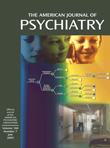To the Editor:
Taijin kyofusho is described as a “culturally distinctive phobia in Japan” in DSM-IV. However, in the indigenous Japanese diagnostic system, depending on the content of the patients’ fear that they will displease or embarrass others,
taijin kyofusho is classified into four subtypes:
sekimen-kyofu (the phobia of blushing),
shubo-kyofu (the phobia of a deformed body),
jikoshisen-kyofu (the phobia of eye-to-eye contact), and
jikoshu-kyofu (the phobia of one’s own foul body odor)
(1). Of these four subtypes,
sekimen-kyofu can reasonably be included in the category of social phobia, according to DSM-IV, since the fear of blushing is a common symptom.
Shubo-kyofu also fulfills the criteria for body dysmorphic disorder in DSM-IV. Thus, at this stage, the notion that
taijin kyofusho is a culture-bound syndrome cannot be held. Furthermore, although the remaining two subtypes,
jikoshisen-kyofu and
jikoshu-kyofu, cannot be adequately assigned to any of the diagnoses in the DSM-IV classification system, a literature review argues against this notion.
For instance, a case has been reported in which an American woman had a fear of embarrassing others by glancing at their genital areas
(2). Although the authors gave a diagnosis of
taijin kyofusho to the patient, a more adequate diagnosis should have been
jikoshisen-kyofu, according to Japan’s classification system. Moreover, it is likely that individuals suffering from
jikoshisen-kyofu are overlooked in the West because
jikoshisen-kyofu is a rare condition, and the vast majority of individuals with it do not seek psychiatric services, even in Japan.
As for
jikoshu-kyofu, a similar condition exists in Western literature (olfactory reference syndrome). Pryse-Phillips
(3) introduced the term, describing patients who are preoccupied with the idea that their bodies emit a foul odor that offends others, a feature identical to that of
jikoshu-kyofu. Therefore, we contend that
jikoshu-kyofu, as well as the other three subtypes of
taijin kyofusho, are not culturally distinctive phobias in Japan.
Since there is no properly conducted population-based study of taijin kyofusho in Japan or in other countries, to our knowledge, it is difficult to make a firm conclusion as to whether all four subtypes of taijin kyofusho are culturally bound or whether some of the subtypes are virtually specific to Japan. It should be recognized, however, that there is a wide gulf between the understanding of taijin kyofusho in Japan, since it incorporates diverse clinical entities, and the current stance in DSM-IV. But is taijin kyofusho really a culturally distinctive phobia? (Other countries treat it as a specific type of phobia in Japan.) This discrepancy could be due to the erroneous introduction of the concept of taijin kyofusho to the West. In future studies, a diagnostic system specifying each subtype of taijin kyofusho should be applied, and more clinical attention should be paid to such sufferers.

